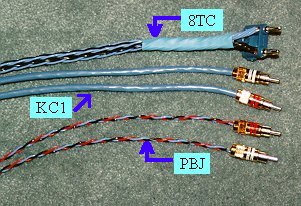Product Review -
Kimber Cables
By John E. Johnson, Jr.
![]()
 |
Kimber Kable; Interconnects and speaker
cables; Model PBJ Interconnects: Three # 19 variable
diameter multistranded copper conductors; Teflon insulation; Gold
plated RCA plugs; $68/1 meter pair; Model KC1 Interconnects:
Three # 19 variable diameter multistranded copper conductors;
Teflon insulation; Semi-metallic shield; Gold plated RCA plugs;
$96/1 meter pair; Model OPT1: Plastic fiber optic
interconnect; Toslink connectors; $50/1 meter; Model 4TC
Speaker Cables: Four multistranded (variable diameter) copper
conductors; Total is # 12 each leg; Teflon insulation; $160/8
foot pair, terminated with spade lugs; Model 8TC Speaker
Cables: Eight multistranded (variable diameter) copper
conductors; Total is # 9 each leg; Teflon insulation; $224/8 foot
pair, terminated with spade lugs; Kimber Kable, 2752 South 1900
West, Ogden, Utah 84401; Phone 801-621-5530; Fax 801-627-6980;
E-Mail [email protected]
When audiophiles think of interconnects and speaker cables,
Kimber is one of the first that comes to mind. This is a brand
that is likely to be on hand in high end audio stores, and for
good reason. Kimber has a wide variety of models from entry level
to multi-kilobuck. And, they are all nice products. The models we
review here are not new, but several readers asked us for our
opinions on them, so . . . voila!
The 4TC and 8TC Speaker Cables have stranded (seven strands of
varying diameter in each conductor) copper wires that are braided
(see photo). Each conductor has a Teflon dielectric (insulator).
The two models differ only in that the 4TC has four conductors
per cable (two per leg), and the 8TC has eight (four per leg).
Our review models were terminated with banana plugs so that we
could easily switch the cables around during testing. Spade lugs
would be a good choice for a sturdier, more permanent
installation, since these cables are rather stiff. The 8TC are
suitable for high current amplifiers, e.g., > 200 watts, while
the 4TC should be satisfactory with lower powered setups.
We used the interconnects and speaker cables with the McCormack
CD system, AMC CD8 CD Player, McCormack Preamplifier, Sunfire
Power Amplifier, Carver Silver 9t Monoblock Power Amplifiers,
Adcom 5500 Power Amplifier, LLano SA3 Monoblock Power Amplifiers,
Electrostatic Research Vista Speakers, Anthony Moore Ribbon
Speakers, and Osborn Eclipse Speakers.
The 4TC and 8TC
speaker cables have a smooth mid-range and tight bass, with a
slightly laid back high end and resultant softening of detail [click here for graph]. They performed well with the electrostatic
speakers and ribbons because these speakers have a lot of up
front precision that can be too "in your face" with
highly detailed music. However, with the Osborn cone speakers,
the music was too soft, in my opinion. Of course, they will
perform differently with various speakers, and you have to take
into account your own personal tastes, but these were our
findings among several referees listening independently. The laid
back high end detail makes them very non fatiguing, so the effect
could be desirable for some listeners.
The OPT1 is a plastic
(proprietary formula) fiber optic Toslink cable for use with the
Toslink optical output from a CD or laserdisc player, input to a
DAC. One of the main advantages of using this cable is there will
be one less possibility for a ground loop (hum) to develop. We
tested this cable with a Pioneer laserdisc player into a Music
Labs DP-102 DAC. We could hear no difference in the fidelity
between the OPT1 and a conventional coax 75 Ohm digital cable [click here for graph], and this is good, since the OPT1 is quite
inexpensive, relatively speaking. You just have to be careful
when handling the cable. Don't put dirty fingers on the exposed
ends, where the light is sent or received. Since DACs are
available with both digital coax as well as Toslink inputs, this
could be handy if you are using the DAC with two sources
(laserdisc and CD), or with a laserdisc player into a DAC via
coax and into an outboard AC-3 or DTS processor via Toslink.
The
PBJ interconnects were our favorite out of the entire group. Each
cable has three conductors, and each conductor has seven copper
strands of varying diameter. One of the conductors is positive,
and two are negative. All three use Teflon dielectric. The cables
are terminated with very solid RCA plugs, which are gold plated.
The KC1s consist of PBJs, surrounded by a semi-metallic shield
with a drain wire that is grounded at the source end of the
cable. KC1s are for professional use where there are a lot of
magnetic field power sources that can induce signal problems in
the cable. The are neutral throughout
the audible spectrum, with no harshness. Good detail and sound
stage [click
here for graph]. At $68/pair, we
feel they are a . The KC1s, on the
other hand, lose some detail because of the drain wire [click here for graph]. However, there are cases where the presence of
other equipment makes the use of this type of cable necessary.
For most applications, in home theater or home audio, the PBJs
are the correct choice.
In summary, the Kimber Kable models that we tested tended to have
a slightly laid back high end (except for the PBJs). This is not
a criticism, but rather a statement about their sonic
personality. They are all solidly constructed and modestly
priced. Kimber sells a lot of these cables, and they are
definitely a brand to check out when you are in the market for
interconnects or speaker cables. It will be interesting to
compare these with some of their other models that contain
silver, in the future.
John E. Johnson, Jr.
![]()
© Copyright 1995, 1996, 1997
Secrets of Home Theater & High Fidelity
Return to Table of Contents for this Issue.

